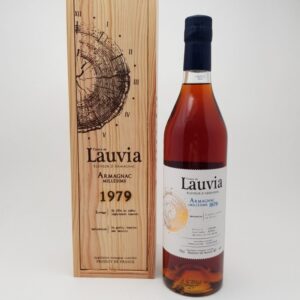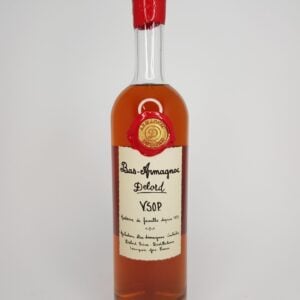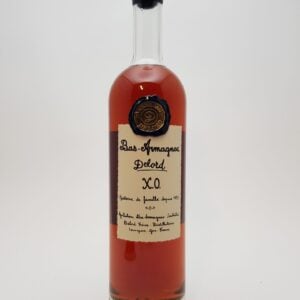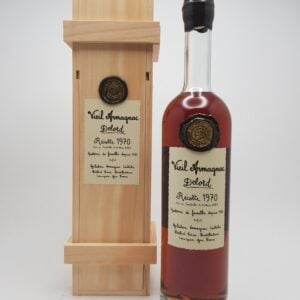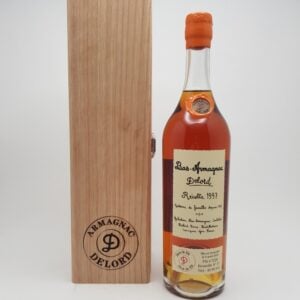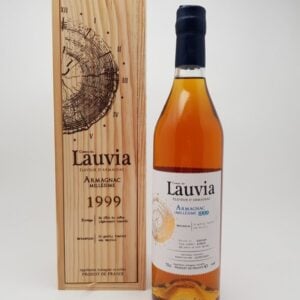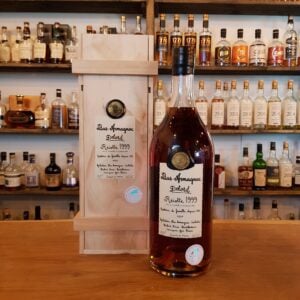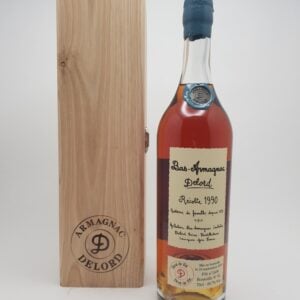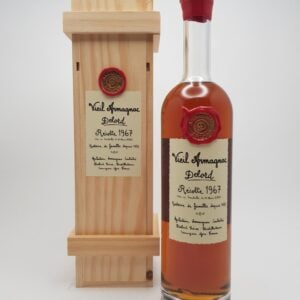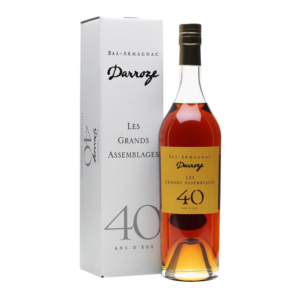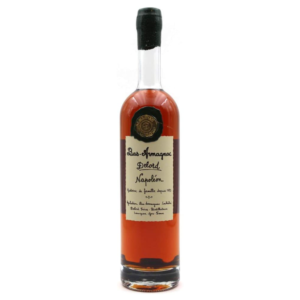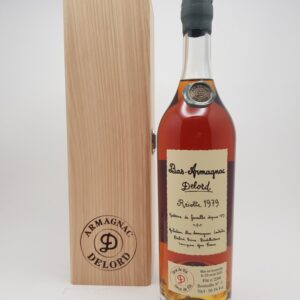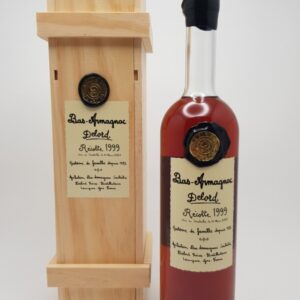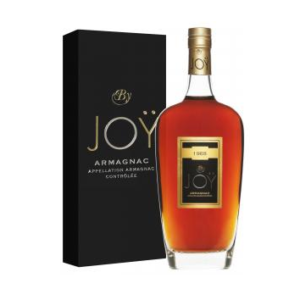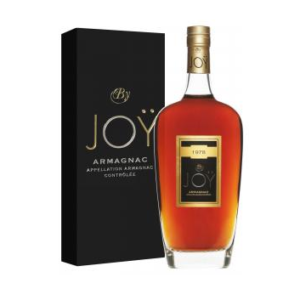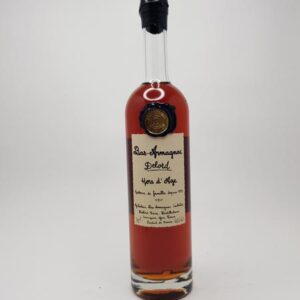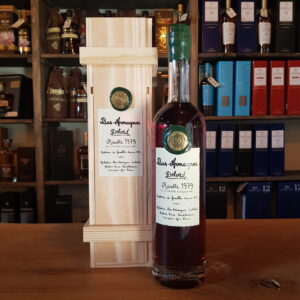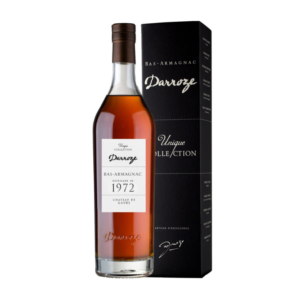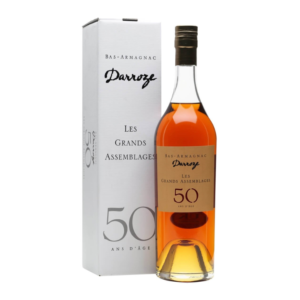Showing 1–24 of 29 resultsSorted by popularity
Armagnac – The Complete Guide
TL;DR: In Brief
- Armagnac is characterized by its rich, rustic character and distinctive robust flavors
- Produced primarily from wine grapes and defined by single-column distillation in an alembic armagnacais
- Found in several styles, including Blanche (unaged), VS (2+ years), VSOP (4+ years), and XO (10+ years)
- Best enjoyed in a tulip-shaped glass at room temperature and can be experienced in a Vieux Carré or Armagnac Sidecar
Disclaimer: This guide is intended for informational purposes for adults over 18 years of age. Vault of Spirits encourages responsible alcohol consumption.
Introduction to Armagnac
Armagnac has a rich history and fascinating craftsmanship behind it. From its origins in France’s Gascony region to its global appreciation today, this spirit has evolved to become one of the world’s most respected brandies.
This guide provides insight into the production, flavor notes, and enjoyment of Armagnac, whether you’re a novice or experienced enthusiast.
Often overshadowed by its more famous cousin Cognac, Armagnac offers a more rustic, intense experience that has captivated connoisseurs for centuries.
How Did Armagnac Originate?
From Past to Present
Armagnac is France’s oldest brandy, with documented production dating back to 1310, predating Cognac by over 150 years.
Its birthplace is the historical Gascony region in southwest France, where local winemakers began distilling their wines to preserve them and create a spirit with medicinal properties.
Initially valued for its therapeutic benefits, Armagnac was prescribed by physicians for various ailments and described as having “40 virtues” in medieval manuscripts.
Over centuries, it transformed from medicine to a celebrated spirit, perfected through generations of artisanal production methods.
Which Historical Milestones Shaped Armagnac?
The 14th century saw the first written records of Armagnac distillation, marking its official entry into documented history.
The development of the unique continuous still known as the alembic armagnacais in the 19th century revolutionized production, creating the distinctive style we know today.
The phylloxera crisis of the late 19th century devastated many vineyards but led to the replanting with specific grape varieties that now define Armagnac’s character.
In 1936, Armagnac received official designation protection (Appellation d’Origine Contrôlée), solidifying its production standards and regional identity.
How Has Armagnac Influenced Cultural Traditions?
In Gascony, Armagnac has been integral to celebrations, from baptisms to weddings, often with families preserving vintages from birth years for special occasions.
The traditional “Pousse Rapière” aperitif, a mix of Armagnac-based liqueur and sparkling wine, remains a symbol of Gascon hospitality.
Armagnac has influenced regional cuisine, featuring in classic dishes like pruneaux à l’Armagnac (Armagnac-soaked prunes) and as a finishing touch in sauces for game meats.
The annual La Flamme de l’Armagnac festival celebrates the distillation season, bringing communities together around this cultural heritage.
Why Is Armagnac Popular Today?
Armagnac has seen renewed interest as craft spirits enthusiasts seek authentic, artisanal products with character and history.
Its smaller production scale compared to Cognac creates an air of exclusivity and discovery that appeals to modern spirits aficionados.
The variety of vintages available offers a unique opportunity to taste specific harvest years, attracting collectors and connoisseurs.
Bartenders have embraced Armagnac for craft cocktails, appreciating its robust flavor profile that stands up to mixing while adding complexity.
How Is Armagnac Produced?
Which Raw Materials Are Used in Production?
Armagnac production begins with specific wine grapes grown in the region’s unique terroir.
The spirit’s character is significantly influenced by the soil types, which range from sandy soils (Bas-Armagnac) to clay-limestone (Ténarèze) and clay-silt (Haut-Armagnac).
The climate of Gascony, with its hot summers and mild winters, creates ideal conditions for growing the grapes that will become Armagnac.
- Ugni Blanc – Provides acidity and freshness to the final spirit
- Baco (Baco 22A) – Adds body and roundness, unique to Armagnac production
- Folle Blanche – Contributes floral, delicate aromas
- Colombard – Brings fruity notes and additional complexity
How Does the Fermentation Process Work?
After harvest, the grapes are pressed and the juice ferments naturally, typically without added sugars or yeasts, preserving regional character.
The fermentation process converts grape sugars into a dry wine with relatively low alcohol content (7-12%) and high acidity – ideal characteristics for distillation.
Unlike Cognac production, Armagnac producers often don’t add sulfites to the base wine, allowing for more rustic, complex flavors to develop.
The base wine is intentionally left unfiltered before distillation, preserving elements that contribute to Armagnac’s distinctive robust character.
Which Distillation Techniques Are Used?
Armagnac’s most distinctive production feature is its unique continuous distillation method, different from Cognac’s double distillation approach.
This single distillation in the alembic armagnacais produces a spirit with lower alcohol content (around 52-60% ABV) than Cognac but retains more congeners and flavor compounds.
- Continuous Distillation (Alembic Armagnacais) – Preserves rustic character and more grape flavor, the traditional and predominant method
- Double Distillation (Charentais Method) – Used by some producers, creates a lighter style closer to Cognac
- Mobile Distilleries – Traditional traveling stills that move between producers during distillation season
What Significance Does Aging Have?
After distillation, the eau-de-vie is transferred to oak barrels, typically from the local Monlezun forest or Limousin and Tronçais regions.
New oak barrels are used initially to impart tannins and color, with the spirit later transferred to older barrels for gentler aging.
The traditional aging cellars, known as chais, maintain specific humidity levels that affect evaporation rates (the “angel’s share”) and aging characteristics.
Unlike many spirits, Armagnac can be aged for extremely long periods – some houses offer vintages from the early 20th century or even older, developing extraordinary complexity.
Which Regions Are Known for Armagnac?
Where Are the Best Variants Produced?
Armagnac production is strictly limited to a defined area in Gascony, southwest France, divided into three distinct growing regions.
Bas-Armagnac (Lower Armagnac) is the most prestigious sub-region, known for producing the most delicate and fruity spirits with notes of plum and violet.
Ténarèze produces fuller-bodied Armagnacs with pronounced structure and earthy characteristics, requiring longer aging to reach their peak quality.
Haut-Armagnac (Upper Armagnac) is the largest but least productive region, with only a few producers creating distinctive spirits that often feature floral notes.
How Do Geography and Climate Affect the Flavor?
The sandy soils of Bas-Armagnac produce grapes with higher acidity, contributing to more fruit-forward spirits with greater finesse.
Ténarèze’s clay-limestone soils result in grapes with more structure and power, creating more robust Armagnacs that evolve significantly with age.
The region’s continental climate with Atlantic influences provides hot summers for ripening and sufficient rainfall for grape development.
The temperature variations between day and night during the growing season help preserve acidity in the grapes, essential for quality Armagnac production.
What New Trends Are Seen in Armagnac Production?
Some innovative producers are experimenting with single-varietal Armagnacs, particularly highlighting Baco or Folle Blanche for their distinctive characteristics.
There’s growing interest in estate-bottled, single-vintage Armagnacs that express the terroir and conditions of specific harvest years.
Several producers are introducing younger, more accessible Armagnacs designed for mixing in cocktails, opening new markets for the spirit.
Cask finishing in barrels previously used for other spirits or wines (like Sauternes or Sherry) is gaining popularity, creating new flavor profiles.
What Do the Different Quality Designations Mean?
Armagnac follows a strict age classification system that indicates the youngest spirit in the blend:
VS (Very Special) or ★★★ (Three Stars): Aged at least 2 years in oak.
VSOP (Very Superior Old Pale): Minimum 4 years of aging, offering more developed flavors.
XO (Extra Old): At least 10 years of aging (increased from 6 years in 2018), showing significant maturity and complexity.
Hors d’âge or Napoléon: Generally aged 10+ years, though these terms are less strictly regulated.
Vintage Armagnac displays a specific harvest year on the label and must be 100% from that year, unlike blends.
How Does Armagnac Taste?
What Characterizes the Typical Flavor Profile?
Armagnac presents a more rustic, robust character than Cognac, with greater intensity and complexity of flavor.
The single distillation method retains more of the original grape character and congeners, creating a fuller body and deeper, earthier profile.
The combination of extended aging in local oak provides pronounced vanilla, spice, and woody notes balanced with fruit characteristics.
- Fruit Elements – Prune, dried apricot, orange peel, quince
- Spice Notes – Vanilla, cinnamon, black pepper, licorice, clove
- Tertiary Aromas – Leather, tobacco, chocolate, coffee, nuts, rancio
How Does the Flavor Vary Between Different Styles?
Blanche (unaged) Armagnac offers fresh grape flavors with floral notes and peppery characteristics, showing the spirit’s raw character.
Younger Armagnacs (VS, VSOP) display more vibrant fruit notes with developing vanilla and wood influence, maintaining some youthful vigor.
XO and older expressions develop deeper complexity with dried fruits, chocolate, nuts, and the prized “rancio” character – a nutty, slightly oxidative quality.
Vintage Armagnacs reflect the specific conditions of their harvest year, with wide variations in style depending on the climate and production choices.
How Does the Flavor Develop with Age?
Fresh off the still, Armagnac is sharp and fiery with raw alcoholic heat and primary fruit notes.
In early aging (2-4 years), it develops roundness as the oak begins to tame the spirit, introducing vanilla and light spice notes.
Medium aging (4-10 years) brings integration of flavors, with fruit and oak finding balance and complexity building.
Extended aging (10+ years) develops secondary and tertiary aromas of dried fruits, nuts, chocolate, leather, and the prized rancio character, with ever-increasing smoothness.
Very old Armagnacs (20+ years) become extraordinarily complex and mellow, with diminished fruit but increased depth, subtlety, and length.
What Signs Reveal High Quality?
Superior Armagnac displays balance between fruit, oak, and alcohol, with no single element dominating the profile.
The finish should be long and evolving, revealing multiple layers of flavor that continue to develop after swallowing.
High-quality examples exhibit complexity with distinguishable aromas and flavors that unfold gradually rather than presenting all at once.
The texture should be smooth and integrated despite the high alcohol content, without harsh alcoholic burn or excessive astringency.
Rancio character – a distinctive nutty, slightly oxidative quality – is prized in aged expressions and signals distinguished maturity.
How Is Armagnac Best Enjoyed?
What Is the Optimal Serving Method?
Armagnac is traditionally served neat at room temperature to fully appreciate its complexity and character.
For serious tasting, allow the Armagnac to rest in the glass for 5-10 minutes before nosing and tasting to let the aromas develop.
A small splash of still water can help open up the aromas and flavors, especially in higher-proof or younger expressions.
While not customary, serving on a single large ice cube can be pleasant for younger Armagnacs or in warmer weather, gently diluting and cooling the spirit.
Which Glass and Temperature Is Ideal?
A tulip-shaped glass with a narrower opening concentrates the aromas and directs them toward the nose, enhancing the tasting experience.
Traditional Armagnac glasses are smaller than typical brandy snifters but follow a similar tapered design principle.
Room temperature (around 18-20°C or 64-68°F) is ideal for most Armagnacs, allowing the full range of aromas to express themselves.
Warming the glass gently in the hands can help release more volatile aromas, particularly beneficial for older expressions with subtle complexity.
How Do You Taste Like an Expert?
Begin with visual assessment, noting the color depth which can range from pale gold in younger expressions to deep amber or mahogany in older vintages.
First nose the Armagnac gently, with your nose just above the glass rim, noting initial impressions before swirling to release more volatile compounds.
Take a small sip and let it coat your entire palate, noting the progression from initial impact (attack) through mid-palate development to the finish.
Pay attention to the texture and body, which should be viscous and smooth in quality examples.
Consider the length and evolution of the finish – superior Armagnacs will continue to reveal new flavors long after swallowing.
Which Dishes Complement Armagnac?
Dark chocolate (70%+ cocoa) pairs excellently with Armagnac, the bitterness complementing the spirit’s rich sweetness and complexity.
Traditional Gascon desserts like prunes soaked in Armagnac create a natural regional pairing that enhances both components.
Blue cheeses, particularly Roquefort, match well with the intensity of aged Armagnac, creating a harmonious sweet-savory balance.
Game dishes, especially duck and venison, complement Armagnac’s earthy, robust character when served alongside or incorporated into sauces.
Coffee and coffee-based desserts create interesting contrasts with Armagnac’s fruit and spice notes, particularly with older expressions.
Which Cocktails Can Be Made with Armagnac?
Which Classic Cocktails Should You Know?
While traditionally enjoyed neat, Armagnac’s robust character makes it excellent in classic brandy cocktails, often bringing more depth than Cognac.
Vieux Carré
- Ingredients: 3/4 oz Armagnac, 3/4 oz rye whiskey, 3/4 oz sweet vermouth, 1/4 oz Bénédictine, 2 dashes Peychaud’s bitters, 2 dashes Angostura bitters
- Preparation: Stir all ingredients with ice and strain into a rocks glass with fresh ice. Garnish with a lemon twist.
- History: Created in the 1930s at the Hotel Monteleone in New Orleans, originally made with Cognac but spectacular with Armagnac’s added intensity.
Armagnac Sidecar
- Ingredients: 2 oz Armagnac, 1 oz Cointreau, 3/4 oz fresh lemon juice
- Preparation: Shake all ingredients with ice and strain into a sugar-rimmed cocktail glass.
- History: A variation on the classic Sidecar created during WWI, with Armagnac providing a more robust base than traditional Cognac.
Which Modern Cocktails Are Worth Trying?
Contemporary mixologists have embraced Armagnac for its distinctive character, creating new cocktails that showcase its depth.
The “French Connection 2.0” combines Armagnac with cold brew coffee, maple syrup, and chocolate bitters for a modern after-dinner drink.
The “Gascon Old Fashioned” substitutes Armagnac for whiskey, using local honey syrup and Armagnac-soaked cherry garnish.
“The Farmhouse” pairs Armagnac with apple cider, lemon juice, and ginger syrup for a rustic, seasonal cocktail reflecting Armagnac’s agricultural heritage.
How Is Armagnac Enjoyed Neat?
Many enthusiasts prefer Armagnac simply served neat in a proper tulip-shaped glass, allowing its complex character to shine without adornment.
A splash of still water (just a few drops) can help open up the aromas and flavors, particularly with cask-strength or very old expressions.
Some prefer Armagnac slightly chilled for a refreshing experience in warmer weather, though extreme cold will mute the more subtle aromatics.
In Gascony, Armagnac is sometimes served alongside a small coffee as a traditional digestif pairing.
Which Homemade Variants Can You Experiment With?
Create your own Armagnac-infused fruits by soaking prunes, figs, or cherries in the spirit for several weeks – excellent for desserts or as accompaniments.
Homemade Armagnac orange liqueur can be made by infusing orange zest and a touch of vanilla in VS or VSOP Armagnac for 2-3 weeks.
For a seasonal treat, infuse Armagnac with cinnamon, star anise, and clove during winter months for a warming spiced variation.
Armagnac can be used to create unique bitters by infusing with herbs, spices, and botanicals for use in your home bar’s cocktail creations.
What Should You Know Before Buying Armagnac?
Which Details Should You Pay Attention to When Buying?
Look for the official AOC designation on the label, ensuring authentic production from the legal Armagnac region in France.
Pay attention to the age classification (VS, VSOP, XO) or vintage year to understand the maturity and potential character of the spirit.
Note the specific sub-region (Bas-Armagnac, Ténarèze, or Haut-Armagnac) which can indicate style differences, with Bas-Armagnac generally most prized.
For vintage Armagnacs, check the bottling date as well as the vintage year – longer barrel aging creates different profiles than those bottled earlier.
Some producers specify grape varieties used, which can provide insight into the flavor profile – Baco tends toward roundness, Folle Blanche toward elegance.
What Do You Get for Your Money in Different Price Ranges?
Entry-level Armagnacs (VS, $40-60) offer solid introduction to the category with youthful vigor and primary fruit notes.
Mid-range expressions (VSOP, $60-90) provide good balance between fruit and oak influence with developing complexity.
Premium Armagnacs (XO, $100-200) deliver significant depth and maturity with tertiary flavors developing and smooth integration.
Ultra-premium and vintage Armagnacs ($200+) present extraordinary complexity, rancio character, and historical significance, particularly from renowned houses and exceptional years.
Generally, Armagnac offers exceptional value compared to Cognac, with comparably aged expressions often costing significantly less.
How Is Armagnac Properly Stored?
Unlike wine, once bottled, Armagnac doesn’t continue to age or improve, though it remains stable for decades when properly stored.
Keep bottles upright (not on their side like wine) to minimize contact between the high-alcohol spirit and the cork.
Store away from direct sunlight in a cool, temperature-stable environment to prevent accelerated evaporation or flavor deterioration.
Once opened, consume within 1-2 years for optimal flavor, though Armagnac will remain drinkable much longer – just expect some gradual oxidation that may alter the profile.
For opened bottles that are less than half full, consider transferring to smaller bottles to reduce air contact and preserve aromas.
Is Armagnac a Good Investment?
Vintage Armagnacs from exceptional years and renowned producers have shown steady appreciation in value, particularly those from the early-to-mid 20th century.
The limited production scale of Armagnac compared to Cognac means that certain vintages become increasingly scarce over time, driving collectibility.
Estate-bottled vintage Armagnacs from small producers can be particularly interesting investments, representing unique expressions of specific terroirs and harvest years.
For investment purposes, focus on provenance, storage conditions, fill level, and maintaining the original packaging which significantly affects resale value.
While potentially lucrative, invest primarily in Armagnacs you would enjoy drinking – the market is less liquid than for whiskies or wines, making quick resale potentially challenging.
Which Brands Do We Recommend?
What’s Best for Beginners?
Château de Laubade VSOP offers an accessible entry point with balanced fruit and oak notes that exemplify classic Armagnac character.
Delord VS presents a youthful but well-crafted introduction to the category at a reasonable price point.
Janneau VSOP provides a slightly lighter style that’s approachable for those transitioning from Cognac or other brown spirits.
Darroze Les Grands Assemblages 8 Years Old delivers excellent quality and complexity for newcomers wanting to experience a more mature expression.
What Will Impress Enthusiasts?
Château de Briat Hors d’Age shows exceptional balance and complexity from a historic estate dating back to the 1500s.
Domaine Boingnères presents intensely aromatic, terroir-driven Armagnacs that showcase the power of single-estate production.
Domaine d’Espérance XO offers extraordinary finesse and aromatic complexity from limited organic production.
Francis Darroze single-vintage expressions from the 1980s and 1990s provide fascinating insight into specific harvest years with significant development.
Which Bottles Are Most Sought After?
Vintage Armagnacs from the houses of Darroze or Laberdolive from the 1950s and 1960s are highly prized by collectors for their extraordinary depth and rancio character.
Pre-phylloxera vintages (pre-1880s) are extremely rare historical artifacts commanding exceptional prices.
Laubade’s Cask Strength Series offers limited-edition single-cask releases that showcase specific barrel expressions.
Marcel Trepout produces extremely limited quantities of estate-bottled Armagnacs with cult status among connoisseurs.
Domaine de Cavaillon vintages from exceptional years (1962, 1973, 1985) have become legendary among Armagnac aficionados.
Where Do You Get the Most Value for Money?
Delord 25 Year Old offers remarkable maturity and complexity at a fraction of the price of similarly aged Cognacs.
Baron de Lustrac VSOP provides excellent quality and character at a mid-range price point.
Domaine du Tariquet XO punches well above its price category with rich fruit notes and well-integrated oak influence.
Vintage Armagnacs from the 1990s represent excellent value compared to older vintages, offering significant maturity while remaining relatively affordable.
Castarède XO delivers extraordinary complexity and length for its price, making it an exceptional value in the premium category.
Frequently Asked Questions
What Is Armagnac?
Armagnac is France’s oldest brandy, produced in the Gascony region of southwest France.
It’s a grape-based spirit distilled primarily using a unique single-distillation method in a column still called an alembic armagnacais.
Unlike Cognac, Armagnac is typically produced by smaller, often family-owned operations, resulting in more diverse and terroir-driven expressions.
It’s governed by strict AOC regulations that define production methods, aging requirements, and geographical boundaries.
How Is Armagnac Produced?
Armagnac begins with wine made from specific grape varieties (primarily Ugni Blanc, Baco, Folle Blanche, and Colombard).
This wine undergoes single continuous distillation in a copper alembic armagnacais still, producing a spirit at 52-60% ABV.
The new spirit is then aged in oak barrels, typically from Gascony or Limousin forests, for a minimum of two years for commercial release.
Master blenders may combine different ages and barrels to create consistent house styles, or bottle single vintages that express a specific year’s character.
What Characterizes Armagnac?
Armagnac typically displays more rustic, robust flavors than Cognac due to its single distillation method, which retains more congeners.
Its flavor profile often includes prunes, dried fruits, vanilla, spices, and with age, develops leather, tobacco, and the prized “rancio” character.
The spirit is categorized by age designations (VS, VSOP, XO) or by specific vintage years, with each approach offering different expressions.
Armagnac is traditionally enjoyed neat as a digestif but has recently gained popularity in craft cocktails that benefit from its intense flavor profile.
Where Can You Buy Armagnac?
Specialty liquor stores with good spirits selections typically carry at least a few Armagnac options, particularly in major cities.
Online retailers like The Whisky Exchange, K&L Wine Merchants, and Fine Drams offer extensive Armagnac selections with shipping to many locations.
For rare vintages or estate-bottled expressions, auction houses like Sotheby’s or specialized spirits auctions present opportunities for collectors.
When visiting France, the Armagnac region itself offers direct purchasing from producers, often including expressions not exported internationally.
Vault of Spirits carries a curated selection of Armagnacs ranging from accessible introductions to rare vintage expressions.

